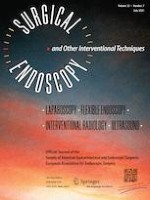Erschienen in:

03.08.2020
Trends of anti-reflux surgery in Denmark 2000–2017: a nationwide registry-based cohort study
verfasst von:
Jonas Sanberg Ljungdalh, Katrine Hass Rubin, Jesper Durup, Kim Christian Houlind
Erschienen in:
Surgical Endoscopy
|
Ausgabe 7/2021
Einloggen, um Zugang zu erhalten
Abstract
Background
The utilisation of laparoscopic fundoplication peaked internationally around 2000. Perioperative morbidity, mortality, and length of stay initially declined as the use of laparoscopic technique increased. Studies indicate that complication rates have increased over time, probably as a consequence of rising age and level of comorbidity. None of these previous studies is nationwide. Therefore, this study aimed to investigate trends in the utilisation of anti-reflux surgery in the entire Danish population from 2000 to 2017.
Methods
Nationwide Danish health registries were utilised to include all Danish patients undergoing anti-reflux surgery 2000–2017. The utilisation of anti-reflux surgery in procedures per 100.000 inhabitants was compared to the utilisation of proton-pump inhibitors for each year. Postoperative complications, mortality, and length of stay per year, including yearly changes, were also calculated.
Results
The use of anti-reflux surgery peaked in 2001 with 5.9 procedures per 100,000 inhabitants and reached its lowest point in 2008 with 2.8 procedures per 100,000 inhabitants. The use of proton-pump inhibitors increased from 3,370 users per 100,000 inhabitants in 2000 to 10,284 users per 100,000 inhabitants in 2017. The 30-day and 90-day mortality ranged from 0 to 1.2%. The 30-day hospital-registered complications were 1.3–6.1%, and the 90-day hospital-registered complications were 2.4–8.3%. Length of stay was consistently low, with a median of 2 days in 2000 reduced to a median of 1 day by 2017.
Conclusion
The utilisation of anti-reflux surgery in Denmark from 2000 to 2017 declined, and the use of PPI increased dramatically. Age, comorbidity, and postoperative complications increased, while the use of laparoscopic technique remained high, and mortality was consistently low.